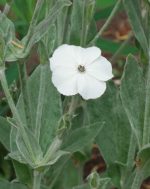 Also known as white cockle, and evening lychnis, white campion is a biennial or short lived perennial in the pink family (Caryophyllaceae) that also includes carnations, baby’s breath, and chickweed. It is native to southeastern Europe but was introduced into the US probably in the 1800s and now can be found in the northern half of the country where it grows in grasslands, pastures, lawns, roadsides, and waste places as well as undisturbed sites.
Also known as white cockle, and evening lychnis, white campion is a biennial or short lived perennial in the pink family (Caryophyllaceae) that also includes carnations, baby’s breath, and chickweed. It is native to southeastern Europe but was introduced into the US probably in the 1800s and now can be found in the northern half of the country where it grows in grasslands, pastures, lawns, roadsides, and waste places as well as undisturbed sites.
Description: White campion has a taproot with horizontal lateral roots and grows 1.5 to 3.5′ tall. The thick branched stem is jointed and covered with sticky hairs. The hairy light green leaves are oval to lanceolate, and attached directly to the stem in pairs. Male and female flowers grow singly in open clusters on different plants. They are fragrant, 1/2″ across, and have five white to pink petals that are deeply notched. Each flower is subtended by a bladder-like structure composed of inflated fused sepals. The fruit is ten-toothed capsule containing numerous seeds so that a single plant can produce 5,000 to 15,000 seeds/per year. Plant reproduce by seeds and occasionally by spreading roots.
Control: Dig, cut, pull, or mow plants as they appear making sure to eliminate all plants before they set seed. In severe cases the herbicide dicamba can be used and should be applied in the bud stage for best results.